

Consolarium blog
Wow! What a response we have had to our Game To Learn afternoon practical workshops! More than half are fully booked and only a few spaces left in the others! As you can see from the table below, we’ve had great interest in our Game Design work shops that focus on Scratch, Build Your Own Blocks, Kodu, RPG Maker VX and 2Simple’s Purple Mash /2DIY as well as Thinkworlds 3D environment building session.
This demonstrates just how keen educators are in Scotland to equip themselves with skills to deliver the Game Design CfE outcomes in their classrooms. What is even more great to see is that it’s not just Computing teachers taking advantage of the sessions, but practioners from all over the curriculum - secondary and primary.
The three sessions that still have spaces in them promise to be an engaging experience for everyone involved.
NB - We will keep you updated via this blog and twitter (follow @gametolearn and the hashtag #gametolearn) should we receive any cancelations or find some more space in any of the full workshops.
|
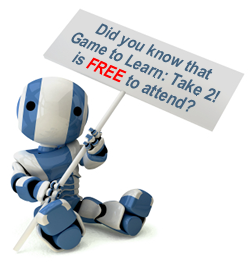 The Consolarium in partnership with JISC are delighted to be bringing the Game To Learn conference to the University of Abertay Dundee on Saturday 19th March.
The Consolarium in partnership with JISC are delighted to be bringing the Game To Learn conference to the University of Abertay Dundee on Saturday 19th March.
The Saturday Programme offers both a fun-packed CPD event for teachers as well as a celebration of the diverse and innovative practice in games-based learning and game design that has been happening in schools across Scotland. Over the past few years the LTS Consolarium initiative has been working with partner schools across Scotland to help nurture the idea that commercially available computer games, that have been developed for entertainment, can be used to help create appealing, purposeful and challenging contexts for learning.
Game Design also offers learners of all ages to engage with the creative process in an engaging and contemprary way that really can facilitate effective CfE delivery. Throughout the morning seminars and afternoon workshops, delegates will have the opportunity to hear from practioners and their use of game design and get some hands on time with game design tools.
Half of the sessions are already fully booked so book your place now to avoid disappointment.
Sessions that are still available include, but not limited to ….
Read about our work with Nintendogs and the Nintendogs case study
Read about our work with the Kinectimals and our Professor Layton case study.
Read about our work with the Eyepet and Gerry’s experiences with Game Based Learning, and others’ experiences in the futurelab report
This may be especially of interest to languages teachers, active school coordinators, PE teachers, class teachers and deputes from Primary and Secondary schools who are interested in seeing how ‘subject specific’ game based learning projects can impact on the whole school.
Read about our work with Just Dance and My French Coach.
Phew! What a start to the day! Follow up your morning seminar with a spot of free lunch, the chance to talk to industry exhibitors then on to a practical, fun filled hands on session. Workshops still available include, but again not limited too..
Using RPG Maker VX to Help Tell Stories & Make Connections Across Learning
Mathew Reid, English Teacher, Garnock Academy, North Ayrshire
“If you’re asking, I’m dancing!” – Join Us for the Just Dance-athon!
Fiona Ferrie, PE Teacher, Doon Academy
Derek Robertson, National Adviser, Consolarium, Learning and Teaching Scotland
Purple Mash: Glow Resources and Game Design with 2DIY
Alan Yeoman, 2Simple Software
Playful, Outdoor and Blended Learning Using GPS
Ollie Bray, National Adviser for Emerging Technologies in Learning, Learning & Teaching Scotland
What are you waitng for? Get your game on now … for FREE!
Hope to see you all on Saturday 19th March 2011
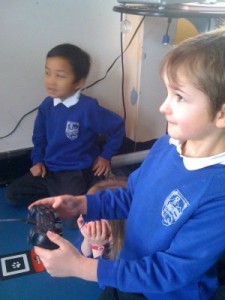 The Eyepet for the Sony PS3 is a resource that the Consolarium team believe has great potential in schools. The promise of an augmented reality Nintendogs type character on the big screen that could be interacted with by groups of children was something that we felt would prove to be a magical experience for young learners. When we first hatched and played with our Eyepet at the Consolarium we experienced for ourselves the power of this technology and we immediately began discussing just what this could bring to teaching and learning. We were enchanted with this beautiful yet vulnerable little creature and after much hand waving in mid-air our Eyepet came to trust us and looking after it became part of our day.
The Eyepet for the Sony PS3 is a resource that the Consolarium team believe has great potential in schools. The promise of an augmented reality Nintendogs type character on the big screen that could be interacted with by groups of children was something that we felt would prove to be a magical experience for young learners. When we first hatched and played with our Eyepet at the Consolarium we experienced for ourselves the power of this technology and we immediately began discussing just what this could bring to teaching and learning. We were enchanted with this beautiful yet vulnerable little creature and after much hand waving in mid-air our Eyepet came to trust us and looking after it became part of our day.
We put Eyepets in a number of schools across Scotland to see how teachers might begin to integrate the resource into their teaching. Cathkin Community Nursery in South Lanarkshire made superb use of their Eyepet and its application in the learning experiences of their learners was commented on favourably by HMIE. We have also spoken with many other teachers who have had similarly positive experiences however we have also had some teachers who have felt that the resource is not for them or for their children because it is too difficult to use. There is a knack to controlling the Eyepet with the card that is supplied (feeding the Eyepet and throwing biscuits for it is really quite tricky when you first start) so maybe this is a training issue for the Consolarium team. The advent of the Move controller for the PS3 has made this aspect of using the Eyepet a lot easier though. This being said there are many teachers in schools that we are working with who are making great progress with the resource as it is.
On a recent visit to Islay I visited Port Charlotte PS where I was introduced to P2-3 teacher Catherine MacMillan. Catherine is one of the teachers in Argyll & Bute who is working with the Eyepet this term. I was introduced to her class, some of whom were working away in the corner about to hatch their first Eyepet. Here they are going through the initial stages of the hatching process:
After the Eyepet had hatched it had to be scanned to see if it was hungry or not. Here we see the children scanning their new Eyepet to see if it requires feeding or not. :
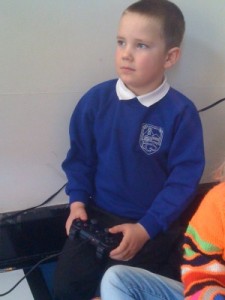 Whenever I have seen the Eyepet used in schools I am always drawn to the look of concentration and involvement on the faces of the children as they play/learn with the resource. Can you see that on the children’s faces here? It also has to be said that the thoughtful and considered application of this engaging resource by teachers really can ‘make learning more creative, challenging and fun.’ This is most certainly the case with Catherine MacMillan because as we talked I quickly saw how she had seen the potential of this resource and just how it could help her deliver learning experiences in Curriculum for Excellence that would offer the challenge, demand and appeal that Port Charlotte PS expects. Her initial foray into making links to other curricular areas was focused on Writing. She saw the perfect opportunity to capitalise on the supportive discussions that were naturally occurring in the children’s groups when they were showing each other what to do with the Eyepet. This instruction giving would be explored further as part of a purposeful and relevant writing activity focusing on instruction writing. One could associate this activity with this Outcome from CfE:
Whenever I have seen the Eyepet used in schools I am always drawn to the look of concentration and involvement on the faces of the children as they play/learn with the resource. Can you see that on the children’s faces here? It also has to be said that the thoughtful and considered application of this engaging resource by teachers really can ‘make learning more creative, challenging and fun.’ This is most certainly the case with Catherine MacMillan because as we talked I quickly saw how she had seen the potential of this resource and just how it could help her deliver learning experiences in Curriculum for Excellence that would offer the challenge, demand and appeal that Port Charlotte PS expects. Her initial foray into making links to other curricular areas was focused on Writing. She saw the perfect opportunity to capitalise on the supportive discussions that were naturally occurring in the children’s groups when they were showing each other what to do with the Eyepet. This instruction giving would be explored further as part of a purposeful and relevant writing activity focusing on instruction writing. One could associate this activity with this Outcome from CfE:
“I am learning to use my notes and other types of writing to help me understand information and ideas, explore problems, generate and develop ideas or create new text.” LIT 1-25a
Have a look at some of the children’s writing:
Here is Catherine talking about how she planned for this activity and how the Eyepet is helping her deliver this aspect of her teaching.
As Catherine and I talked the children played away quite confidently and contentedly and took charge of looking after their new Eyepet. I took the opportunity to continue talking about just what technologies such as games can bring to the classroom. Catherine had clearly given some serious thought to the application and appeal of a resource such as the Eyepet and as we talked she focused on the following aspects as positive reasons to use the Eyepet and also what she had seen for herself in the short time that she had been using the resource:
As you can see from the video, the children still carried on working independently as we chatted. So much so that even when the bell rang it took some encouraging to get the children away from their Eyepet and out to play:
We also discussed how, amongst other things, Catherine and her colleagues are using the Eyepet to aid transition from the nursery class to Primary 1. You can hear our discussion (over the children using the hairdryer to dry their Eyepet) here:
Transcript of discussion with Catherine MacMillan
We will be sharing some more experiences of teachers in Scottish classrooms who are using the Eyepet over the coming months. No doubt we will see some more innovative yet grounded practice from many of the teachers currently using the resource. If you are using this resource in your own setting then please do get in touch and share with us what your experience has been.
At the Game To Learn: Take2! Conference in Dundee on Saturday 19 March Brian McLaren, DHT Clackmannan PS (ex Consolarium Development Officer) will be delivering a seminar in which he will talk about his experience of leading the Eyepet initiative for the Consolarium. Come along to hear what Brian has to say.
*Full transcription of videos to come
More*Guest post from Stuart Meldrum at Hawick High School who is involved with our rapid prototyping initiative.
“Cool sir! That looks amazing!…but what is it?”
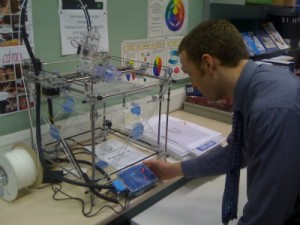 That is generally the reaction from pupils (and staff) when they first set eyes on the RapMan currently sitting in my classroom. This fantastic monster looks like it has been pieced together with whatever spare parts were lying around the workshop and that isn’t actually too far from the truth. The kit that LTScotland have provided to three schools was essentially a thousand piece jigsaw, where the parts are all standard components like nuts, bolts, and washers, with some laser cut acrylic sheets thrown in. This meant that a lot of my time was spent piecing it all together, this is not a quick task! There is a prebuilt version available for quite a bit more cash.
That is generally the reaction from pupils (and staff) when they first set eyes on the RapMan currently sitting in my classroom. This fantastic monster looks like it has been pieced together with whatever spare parts were lying around the workshop and that isn’t actually too far from the truth. The kit that LTScotland have provided to three schools was essentially a thousand piece jigsaw, where the parts are all standard components like nuts, bolts, and washers, with some laser cut acrylic sheets thrown in. This meant that a lot of my time was spent piecing it all together, this is not a quick task! There is a prebuilt version available for quite a bit more cash.
For the uninitiated the RapMan is one example of a Rapid-Prototyper. This essentially means that it is a machine that can print in 3 dimensions, but instead of leaving a trail of ink the RapMan has a head that can move in two directions and pulls though a filament of plastic, heating it as it moves. The melted plastic is trailled over a bed and a 2D shape is laid out. Then the bed is lowered and the head starts leaving another trail on top of the first. Over time and successive layers the melted plastic fuses together to build up a 3D shape.
For years in Design and Technology departments we have been drawing and designing things in 3D using CAD software but now we have an affordable method or realising these designs. Normally the cost of this sort of machine puts it well out of reach of schools.
Now that our RapMan is up and running in Hawick High School we have loads of ideas as to how we could start to use it in our courses. It lends itself naturally to Product Design where pupils have to create models of their designs, but it fits in all the way down the school too. Also, now that Computer Aided Manufacture is explicitly mentioned in the Level 3 and Level 4 Outcomes and Experiences (TCH 3.13 and TCH 4.15) schools will be increasingly looking to use this technology.
Listen to Stuart’s take on the challenges that he has faced in trying to get the rapid protoyping kit up and running in Hawick High School.
Although we are heavily focused on game based learning and games design at the Consolarium our remit also includes exploring other emerging technologies and how these can impact on teaching and learning. To this end we are currently working with schools in Argyll & Bute, Scottish Borders and Edinburgh City to explore how rapid prototyping kit might be able to play a part in the Design & Technology curriculum.
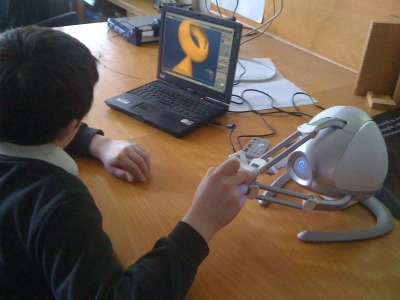 What this kit allows us to do is create 3D objects that can then be ‘printed’ in 3D form via the Rapman. This could allow you to create piece of jewellery for example on the computer, in 3D form, and for this to be printed out in 3D form.
What this kit allows us to do is create 3D objects that can then be ‘printed’ in 3D form via the Rapman. This could allow you to create piece of jewellery for example on the computer, in 3D form, and for this to be printed out in 3D form.
We purchased three sets of kit from Anarkik 3D that would enable us to begin this work. This kit includes the Falcon 3D Mouse, the Rapman 3D printer and the Cloud 9 software. The Rapman 3D printer can be purchased fully assembled or in flat pack. Obviously the costs are less for the flat packed version.
I visited Islay High School in Argyll & Bute recently where I met with Ian Stuart who is looking to integrate this kit in to the Design & Tech experiences of his pupils. The day that I arrived I saw the pupils using the software and the 3D mouse to create a pendant that could be attached to a necklace. The school is still in the very early stages of getting to grips with this kit and over the past few months it is fair to say that it has faced some challenges particularly in relation to the construction of the flat-packed Rapman printer. Their experiences to date were captured in this chat with Ian Stuart.
Transcript of discussion with Ian Stuart
Even though it is clear that the flat packed option of the Rapman 3D printer does mean an investment of time and effort in order to build it I have to say that what I saw at Islay HS suggests that this kit can really play a part in pupils experiences of Product Design and Computer Aided Manufacture. Some of the pupils’ designs were rather impressive and their feedback about using the Falcon 3D mouse was very positive.
We will follow up and report on the experiences of Islay HS with this exciting resource.
MoreIn 2008 the Chief Executive of McDonalds UK argued that ‘Computer games were to blame for childhood obesity’. More recently a research study carried out by the World Health Organisation that was featured in the Journal of Paediatrics has named computer games, along with TV, as a main cause of childhood obesity - reporting:
“…over 70,000 teenagers from 34 different nations are overweight or obese. It called a sedentary lifestyle - ‘spending three hours or more per day watching TV, playing computer games, or chatting with friends’ - is the main reason behind the figure.”
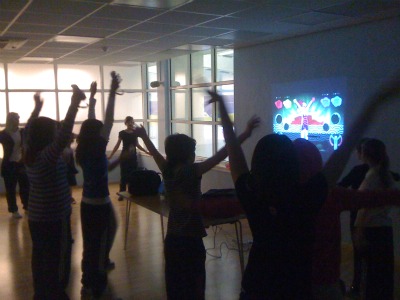 The folk devil image that has been associated with computer games is one that the team at the Consolarium have always been aware of and keen to explore and possibly deconstruct in a sensitive and honest fashion. We argue that games should play a part of a rounded and varied range of experiences for young children’s development and that a diet solely of sedentary game-play is possibly not the best way for young people to spend their time. To this end we have been keen to explore how the increasing active physical participation offered by technologies and games consoles might be used in an appropriate and realistic way to impact in a positive fashion on levels of children’s physical activity.
The folk devil image that has been associated with computer games is one that the team at the Consolarium have always been aware of and keen to explore and possibly deconstruct in a sensitive and honest fashion. We argue that games should play a part of a rounded and varied range of experiences for young children’s development and that a diet solely of sedentary game-play is possibly not the best way for young people to spend their time. To this end we have been keen to explore how the increasing active physical participation offered by technologies and games consoles might be used in an appropriate and realistic way to impact in a positive fashion on levels of children’s physical activity.
Having previously been unsuccessful in our efforts to explore dance mat technology our imagination and ideas were pricked when we heard about the Just Dance title for the Wii. The actual experience offered by this game coupled with the contemporary music (as well as some 70’s classics) was such that we were of the opinion that this game might just be something that would work in schools…
At SLF10 the Consolarium team’s area at the LTS stand proved to be very busy with a lot of interest in the games. The team whole-heartedly threw themselves into demonstrating the games that we were promoting as appropriate and successful learning resources, one of which was Just Dance. Have a look at some of the Consolarium team in action playing this game alongside the BrainPop robot and a very talented young dancer:
Our intention was to identify and work with interested school partners who would be keen to explore just how this resource might be of use in relation to engaging teenage girls with physical exercise. Having spoken with many PE teachers over the past few years about the use of GBL in their domain they often talked about the promise of using a dance related game linked to a game console as something that they thought might encourage teenage girls to become more interested in and motivated to participate with physical exercise. Also, we were encouraged by initiatives such as Girls on the Move and by the many references to Dance and girls uptake with PE that were made in a recent HMIE publication about PE in schools.
Sometimes serendipitous moments lead to great things and as it so happened a group of girls from Doon Academy came along to the Consolarium stand at SLF10 and took over! Four girls used the Wii controller whilst the other eight stood behind, without controllers and danced and danced and danced. In that moment our Just dance in schools initiative was born. Discussions with Fiona Ferrie, the PE teacher from Doon Academy and Alison Crawford from East Ayrshire Council led to a number of Nintendo Wiis and Just Dance games being loaned to the Secondary schools in that authority. The focus would be on the resources use with girls in PE. Post SLF10, the resources were despatched and the project was underway…
A couple of weeks ago I made my way down to Doon Academy to see just how Just Dance had impacted in the life of the school. I was full of hope that this resource would be a great success but as with all things the idea and the practical application in reality do not always match up! This was not the case here. What I witnessed at Doon Academy was up there with the very best successes that the LTS Consolarium team and their school partners have ever had.
I was met by the class teacher Fiona Ferrie and taken to the PE department to see S.1 girls using Just Dance in their PE Lesson. Have a look at the girls in action with the resource:
The PE teachers at the school remarked on the remarkable impact that this game was having teenage girls’ attitudes to physical activity. What they were seeing included:
• At least a 50% increase in girls from 3rd and 4th year taking part in PE
• A decrease in notes from parents asking for their daughters to be excused from PE
• A decrease in instances of girls not bringing their kit for PE
• A collegiate group of learners engaging with the PE in a supportive fashion with no real interest in high scores or competition
It seems that the positive impact of this resource and its practical application also seemed to have worked on the boys in the school too! Their involvement in any Just Dance related activity seems to be just as, (if not more in some cases) wholehearted and committed than that of some of the girls! This is quite evident in the following videos that show a Just Dance event that took place in the school library. Have a look at the dance crazy pupils of Doon Academy dancing to Eye of the Tiger:
Here they are dancing to a Katy Perry number:
I had a brief discussion with Fiona Ferrie at the end of my visit to try to encapsulate just what had been happening in her school. Have a listen to what Fiona has to say about her experience with Just Dance in her school:
(Transcript to follow)
It seems that this resource has helped encourage a whole school approach to activity through dance. It seems that even the school dinner ladies are using the resource and want activity as part of their daily working lives!
At the Consolarium we are always trying to explore ways in which technologies and games can impact favourably of learning. An awareness of issues of concern about games and technologies are always part of what we do but our job is to see how we can enhance the learning experiences and opportunities of our pupils. Our experience continually shows that thoughtful and realistic application of games by class teachers working in schools throughout Scotland can help enhance teaching and learning. The Doon Academy example is just another example in a long line of work that we have done that shows just how technologies can enhance learning.
Fiona Ferrie and Alison Crawford will be sharing their experience at the Game to Learn: Take2! Conference in Dundee on Saturday 19th March.
Thank you to everyone at Doon Academy and East Ayrshire Council for their support commitment to and with this project.
MoreAt the Consolarium we have a long history in trying out games built for entertainment in the educational setting. This has been particularly true of games such as Nintendogs and Eyepet. These games were most definitely built for entertainment but the educational potential within these superb digital experiences is fantastic. As always, we continue to look to see what else can be explored in the games world in terms of its appropriate use in teaching and learning contexts…
The Kinect system for Microsoft’s Xbox360 games console was something that we greatly anticipated, particularity when we saw how the game Kinectimals might allow us to continue the theme of caring and nurturing for a digital creature/pet that was central to the experience in using Nintendogs and the Eyepet. If you haven’t seen Kinectimals then have a quick look:
As you can see we have the most wonderful participative world that has no controller but the player/players themselves! Just what, we wondered, could such a resource bring to the classroom and how it could support opportunities to develop rich learning experiences within Curriculum for Excellence.
Having shared this idea and proposed pilot project with the delegates at the LTS Early Years conference in November 2010 we were approached by Judi Regan from Menzieshill Nursery School in Dundee who said that she’d be more than willing to try out the resource in her setting. This agreed and after a discussion about its possible use we loaned the kit out to the school and let them get on with it. Alas, as is often the case with educational technology in schools, some technical issues presented some small hurdles that had to be cleared before any teaching and learning could be addressed! Issues related to linking up the audio to a pair of old PC speakers were eventually rectified and it was all systems go (apart from a scratched disc that had to be replaced)!
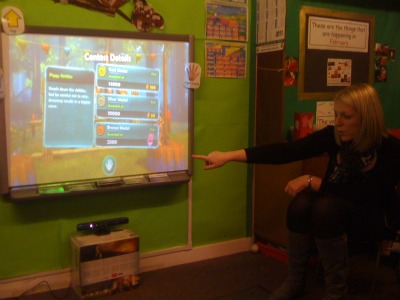 The resource was introduced to the staff by Judi and Louise Reid at last week’s in-service day and this was followed up today by me when I spent all morning working with various groups of children and their workers in order to set up profiles and start them on their journey with Kinectimals. It must be said that initial reactions to the resource from the children varied from bemusement to excitement but with very many of them wanting to know when it would be their turn!
The resource was introduced to the staff by Judi and Louise Reid at last week’s in-service day and this was followed up today by me when I spent all morning working with various groups of children and their workers in order to set up profiles and start them on their journey with Kinectimals. It must be said that initial reactions to the resource from the children varied from bemusement to excitement but with very many of them wanting to know when it would be their turn!
Lousie Reid (Acting Head) and Judi Regan will be sharing their experiences via guest blogposts on our site over the next few weeks as well as through their seminar at the Game To Learn: Take 2! GBL Conference in Dundee on Saturday 19 March. Come along to hear their story and in the meantime have a listen to our chat with Judi about the early beginnings of their Kinectimals project.
Judi Regan discussion transcript
If you are also using Kinectimals in your seting we’d love to hear from you. Watch out for the developing story from the team and children at Menzieshill Nursery School.
MoreLearning about word, excel and powerpoint is not going to give you a career in the high tech creative industries.

At the Consolarium, we have been developing resources and capacity throughout Scotland in the area of Game Design. We were delighted to have one of our pilot schools, Girvan Primary School involved with this project. This is the trailer that has been produced for the Livingston Hope Skills Review. Near the start of the film, teacher Avril Denton and her class celebrate their achievements in Game Design with Kodu from Microsoft. You can read more about the pupils experience in Girvan Primary School here
The review itself illustrates the need for building capacity in digital creation from an early age in schools in the UK. Our new Curriculum for Excellence recognises this, and has explicit outcomes relating to game design and digital creation. We really need to embrace this area and give all our learners the opportunity for culturally relevant creativity and challenge. At the Consolarium we will continue to develop resources to support learners and teachers in Scotland in game design tools and techniques.
The NESTA report can be found on the NESTA home page.
More
Find us on